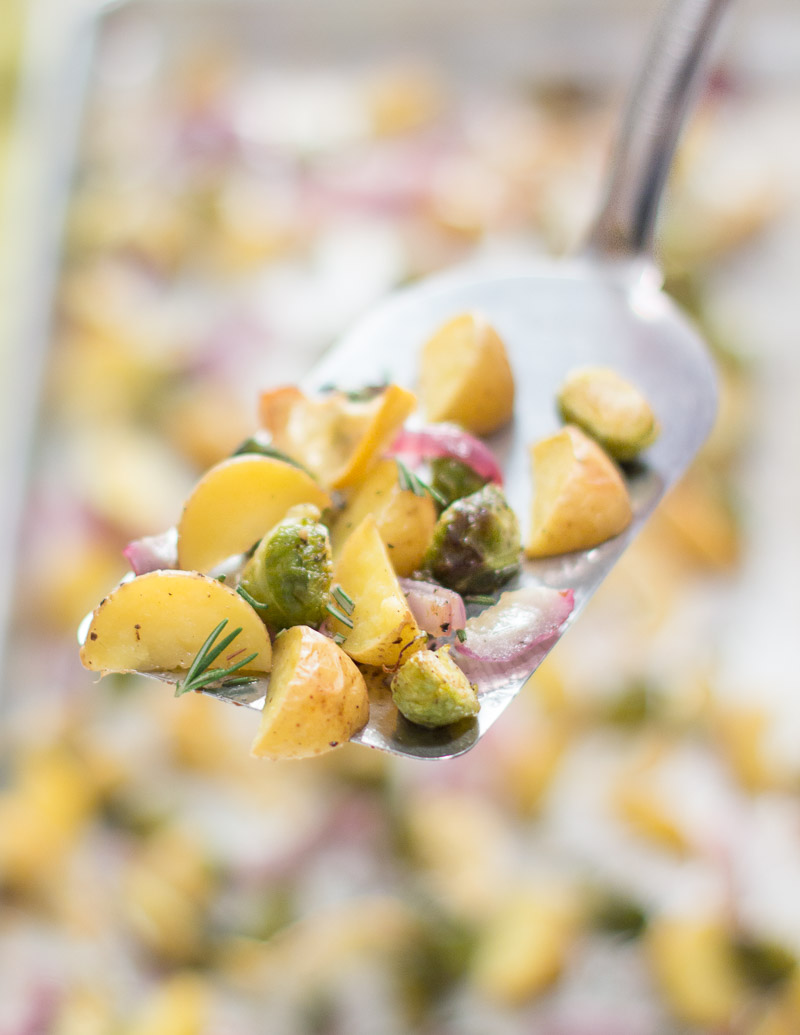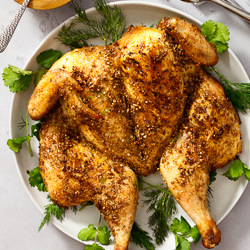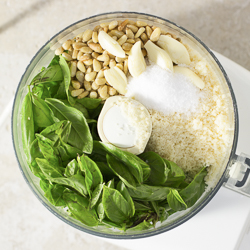What’s so great about roasted vegetables, this Roasted Brussels Sprouts and Potatoes with Lemon and Rosemary, for example? Roasting adds yummy browning and caramelization. Think, for example, about the flavor difference between a poached chicken breast and one that’s been pan-seared. That difference, my friends, is caramelization. And it’s goooood.
Roasting vegetables is also a great way to use up odds and ends in the fridge. Almost anything that can’t go in a salad can be roasted—plus even a few, like carrots and tomatoes, that can—and almost any combination of vegetables works.
So then, here’s how to roast vegetables.
1. Preheat the oven to 400 or 425°F.
It doesn’t matter a lot exactly what temperature you use. You could argue for a slightly lower temperature and longer time for dense vegetables, like carrots or winter squash, or if the vegetables are in larger pieces, and I’d agree with your argument. But it’s not critical.
TIP If you have convection, use it.
Lots of people have the convection feature but hardly use it. Here’s a post all about convection cooking—but basically, with convection, a fan in the oven blows the air around, and air that’s circulating is more efficient at cooking than air that’s stagnant. So convection cooking generally happens more quickly. (Keep a closer eye on things until you get used to it.)
Even better, though, is the fact that it’s conducive to that delicious browning.
2. Use whatever combination of vegetables you like, but cut each type of vegetable into the same size pieces.
The potato pieces don’t have to be the same size as the onion pieces, which don’t have to be the same as the Brussels sprouts. But all the potatoes should be the same as each other. Et cetera.
This helps them cook evenly. No one wants a perfectly tender carrot and a jarringly crisp one in the same bite. Nor do you want to have to overcook some potato pieces because others are still al dente.
TIP While it doesn’t really matter what shape you cut your vegetables into, if everything is too same-same, it makes for a visually boring dish, while if everything is different, it can look like a mish-mosh.
I like combinations where several things are the same shape but one or two are different. For example, in my Roasted Brussels Sprouts and Potatoes with Lemon and Rosemary, the Brussels sprouts and potatoes are wedges, but the onion is in strips.
3. Toss the vegetables with olive oil, salt, and pepper.
How much? Don’t be shy. Fat is conducive to crispiness and browning, plus it’ll help keep your vegetables from sticking to the baking sheet. And vegetables tend to need a lot of salt and pepper to really shine.
TIP If I want to taste the seasoning on my vegetables, but I don’t want to eat a raw bite of, say, potato, I taste the spoon that I’m using to toss them. It should be coated with a decent layer of oil, and that oil should be assertively seasoned. If not, I add more.
4. Spread the vegetables in an even layer on a large, rimmed baking sheet.
An even layer will help with even cooking.
5. Don’t get too crowded.
All food, including vegetables, has a high percentage of water. As the food heats, the water becomes steam and cooks off. If your food doesn’t have enough room around it—if there are too many steaks in your skillet or too many carrots on your baking sheet—it’ll end up doing more steaming than searing, sacrificing browning.
TIP Own more than one large, rimmed baking sheet and use both when necessary.
6. Add various vegetables according to how long they need to cook.
In other words, put the longest-cooking vegetables in the oven first and the quickest-cooking vegetables last, the goal being that they’re all done at the same time.
In my Roasted Brussels Sprouts and Potatoes with Lemon and Rosemary, the Brussels sprouts and potatoes cook for 10 minutes before the onion is added.
7. Bake until tender.
Tossing the vegetables halfway through is usually a good idea, but not critical. Usually I do this as I’m adding a quicker-cooking vegetable to the ones already in the oven.
BONUS POINTS
A few ways to enhance.
1. Add goodies to your vegetables while they cook. Goodies might include hearty herbs like rosemary or thyme, spices like curry powder or smoked paprika, whole cloves of garlic, or thin slices of citrus, peel and all.
My Roasted Brussels Sprouts and Potatoes with Lemon and Rosemary has—you guessed it—lemon and rosemary!
2. Add goodies to your vegetables after they cook. Drizzle with good-quality olive oil or balsamic vinegar. Top with chopped tender herbs like parsley, chives, or cilantro. Or sprinkle with crumbled blue cheese, shaved Parmesan, or toasted seeds or nuts.
What to do with all these roasted vegetables?
Serve them as a side dish, sure. But I like them as a bed for a pan-seared protein like chicken or fish. And as a topping for a bed of arugula—roasted vegetable salad, anyone?—a baked potato, or a bowl of farro or polenta.
I always make great piles, thinking I’ll use the leftovers for one of the above. But I usually end up eating them all in one sitting.
My favorite? Roasted vegetables with fried or poached eggs on top, plus plenty of hot sauce.
:)
Need more inspiration?
The Kitchen also posted about how to roast vegetables. They say pretty much the same things I do, but in a slightly different way.
My recipe for Bon Appetit for Roasted Carrots, Parsnips, and Meyer Lemons.
My recipe Cumin-Roasted Potatoes.












